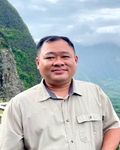2022
Piphal Heng
- Interim Associate Director
- University of Hawaii at Manoa

Abstract
My research examines Theravada landscape and organizational change in post-Angkorian Cambodia (fifteenth to eighteenth century). Cambodia underwent multiple organizational shifts: the adoption of Theravada, the collapse of Angkor empire, a southward shift in population concurrent with an intensified participation in maritime trade, and a decline in stone temple constructions and inscriptions. Theravada pagodas replaced and co-opted the Angkorian Hindu-Mahayana temples to become loci of communities and centers of power. In what traces does the physical landscape record demographic and economic shifts from a Hindu-Mahayana to Theravada worldview? My archaeological work uses pagoda-centered settlement organization as a lens for examining settlement organization change following the Angkorian period.
Abstract
This transdisciplinary research studies changes in urban organization from the Angkorian to the Early Modern period in Angkor, Cambodia. Blending archaeological methods with remote sensing data analysis, this project documents urban re-organization and religious change in the former capital that occurred with the 15th-century collapse of Angkor, SE Asia’s largest premodern empire. As political centers moved south, region-wide changes transformed Greater Angkor into a pilgrimage center. This research focuses on how Angkor's urban neighborhoods changed form and scale by excavating inside Angkor Wat, which became an international pilgrimage site. The field components of this project involve capacity-building for young Cambodian archaeologists and students to study ancient urbanism and how Angkor became the symbol of Cambodia’s national heritage.

